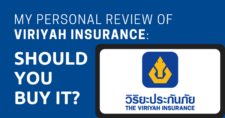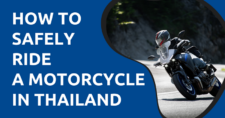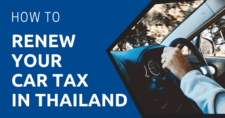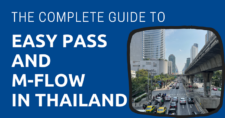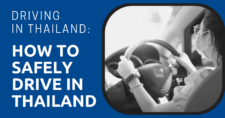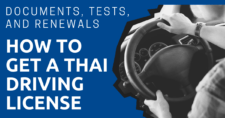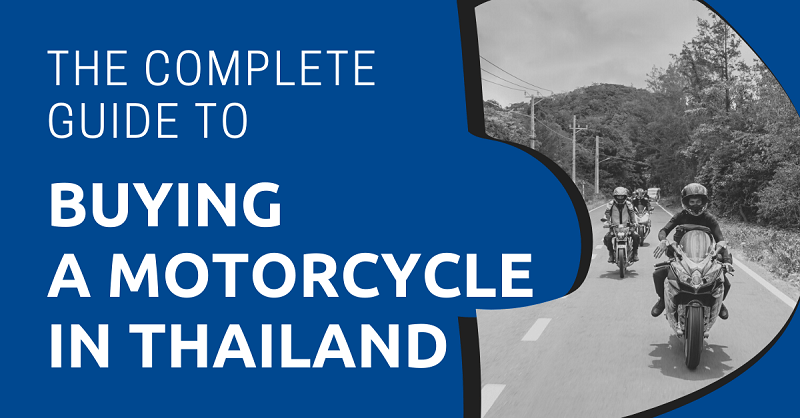
Visit Thailand – or indeed any country in Southeast Asia – and you’ll quickly notice that motorcycles are everywhere. And it’s easy to guess why. Motorcycles are inexpensive to buy, inexpensive to run, can navigate gracefully through gridlocked cars and easily negotiate narrow paths and alleyways. For many long-term Thailand expats buying a motorcycle is a no-brainer.
However, there are plenty of downsides, too – chief among them Thailand’s incredibly high rate of road deaths, most of whom are motorcyclists. It’s all too easy on Thailand’s roads to be side-swiped by a bus or ploughed down by a pick-up truck running a red light.
Riding a motorcycle in Thailand is certainly not for the faint-hearted – but for some expats, the many positives a motorcycle can bring tend to win out.
If you have decided that buying a motorcycle is for you, then this article will guide you through the process. We’ll run through the pros and cons of buying new or secondhand, show you how and where to get your bike legally registered and offer some advice for taking your motorcycle on the road for the first time.
We’ll also advise you on how to keep your motorcycle running in tip-top shape, and where to pay your tax to keep it legal.
"*" indicates required fields
Disclaimer: This article may include links to products or services offered by ExpatDen’s partners, which give us commissions when you click on them. Although this may influence how they appear in the text, we only recommend solutions that we would use in your situation. Read more in our Advertising Disclosure.
Contents
Where to Buy Your Motorcycle
The first thing you’ll need to decide when buying your motorcycle is whether to buy brand new or secondhand.
There are – as ever – pros and cons to each. Buying new guarantees your bike will be top quality and fresh-out-the-factory, with little chance of it sputtering to a halt half a kilometer outside the dealership. You also have the option of financing, and can pay your road tax online for up to seven years after purchase, avoiding the irritating annual trip to the service center. On the other hand, secondhand motorcycles are often significantly cheaper, and many are just as roadworthy as a new motorcycle.
Let’s look at where to shop for each:
Buying New
There are motorcycle dealerships all over Thailand. Big brands like Honda and Yamaha will have their own dealerships, but there are a few independents out there too who might be able to offer you a better deal if pushed. Many of them will have their motorcycles out on display on the pavement, so comparing prices between dealerships is simple.
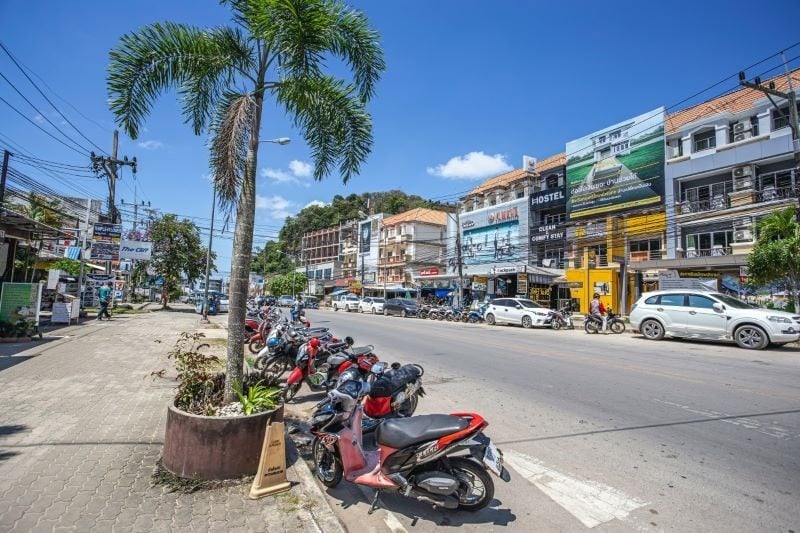
Before buying your motorcycle at the dealership, you’ll need the following documents:
- Your original passport plus copies of the photo page, current visa, and extension-of-stay stamp.
- Residence Certificate- see here for more information on how to get hold of one of these.
If you want to buy your bike on hire purchase, you’ll need a long-stay visa and proof of income – a business visa or work permit will do. You’ll also need to bring six months of bank statements and you’ll likely need to show evidence of employment such as your contract.
Unfortunately, financing isn’t an option for those on tourist visas – instead, the dealership may throw in some freebies such as a branded jacket or road tax covered for a year.
Many independent dealers will push you to opt for leasing as it generates more profit for them, so they may also price their motorcycles slightly higher to incentivize you. If this is the case, just visit the official dealership.
Buying Secondhand
Buying secondhand is probably the most common way expats get their hands on a motorcycle – most often from other expats. People return home all the time, and they’re almost always keen to sell off their motorcycles before they go – often for a knock-down price. It’s not uncommon to pay half or even a third of what it would cost in a dealership.
If you decide to buy from a third-party, there are plenty of options. Facebook Marketplace is an option and Facebook groups such as Bangkok Expats Classifieds Forum frequently have postings about bikes for sale. There are also many secondhand dealerships dotted around Thailand – many are pretty simple outdoor stores under tarpaulins, with prices plastered on the bike windscreens.
It goes without saying that you should exercise caution when buying secondhand, especially from an unknown third-party. Ask to take the bike for a spin first to see how it handles. Lights and brakes not functioning perfectly? Smoke belching out of the exhaust? Bald tyres? Leaking oil? You’re probably better off leaving it there, regardless of how good the price is.
Renting
Many expats prefer to avoid purchasing at all, and simply rent their bikes. Renting comes with a number of advantages. You don’t have to deal with the headache of selling the bike when you’re done with it – simply return it to the rental office. Maintenance is all included with the price, too, so no surprise bills when your bike suddenly starts leaking oil.
However, it does make less financial sense to rent long-term, particularly when secondhand bikes are so relatively inexpensive – your THB 20,000 Honda Click will have paid for itself in a year if you buy it instead of rent it.
Some bike rentals such as Fatboy’s offer the best of both worlds with rent-to-buy schemes – however these usually work out as costing a little more than just buying the bike secondhand would have.
Choosing Your Motorcycle
Once you’ve decided where you’re going to buy, it’s time to pick out your bike.
For most expats looking for something to get them to work and back a small 125cc scooter will be more than adequate. Two of the most popular brands are the Honda Click and the Yamaha GT, which are lightweight, easy to handle automatic bikes. There are also the slightly heftier Vespa-like Yamaha Fino and Honda Scoopy. All of these bikes will cost you between THB 45,000 to THB 51,000 new, depending on the model or dealer.
If you’re planning on taking your bike further afield or simply want something with a bit more power, some popular 155cc bikes include the Honda PCX and Yamaha Nmax. Both these bikes will cost you between THB 80,000 to THB 110,000 new.
However, if you’re really passionate about your bikes, you might want to consider getting a sports bike. Some popular brands including the 400cc Kawasaki Ninja, or the exceptionally cool-looking 350cc Royal Enfield Bullet.
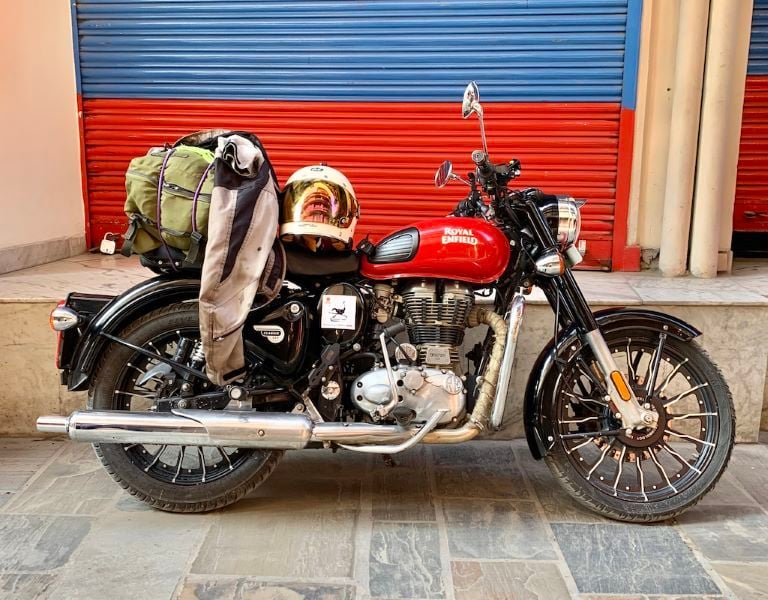
For a new Ninja you can expect to pay at least THB 300,000 (and more likely over a million). Bullets are much more reasonably priced, starting at around THB 150,000.
Registering/Transferring Your Motorcycle
All vehicles in Thailand require a tabien rot to be road-legal, known more commonly as a ‘green book.’ The green book contains a list of all the bike’s owners, its serial number and licence plate.
If you’re buying new from a dealer, they’ll provide you with the green book there and then. However, if you’re buying secondhand you’ll need to register your ownership of the bike with the Department of Land Transport yourself.
Here’s how to do it:
Documents Required
Here’s what you’ll need to get your bike registered:
- Application Form – you’ll be provided with one of these at the DLT office.
- A copies of your passport (photo page, current visa and most recent Thailand entry stamp), plus the original.
- Residence Certificate – you can get one of these from immigration or your own embassy.
- The original green book for the bike.
- Copies of the original owner’s passport (if they’re a foreigner) or ID card (if they’re a Thai citizen).
- A photocopy of the current owner’s tabien baan (house book) – if buying from a non-Thai citizen, a residence certificate can be substituted here instead.
The process costs THB 200, with an extra THB 300 for mandatory accident insurance.
Department of Land Transport
Once you’ve prepared all of your documents, you’ll need to head to the Department of Land Transport to register the transfer. Note that you’ll need to go to the branch where the bike was originally registered, not your local branch (if they’re not the same place) – this should be printed inside your green book.
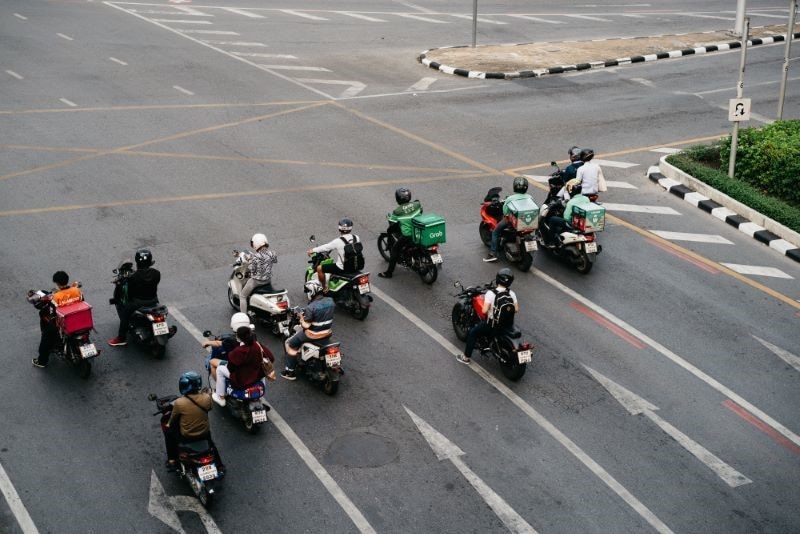
It’s a good idea for both the buyer and seller to make the trip to the DLT together – this avoids any potential mishaps or confusion. It’s also a good idea to bring the bike along too in case it requires an inspection.
Once you’re at the DLT, simply hand over your documents and the money and wait for the transfer to be completed. It’s a fairly quick process – you can expect to be in and out in under an hour, provided it’s not too busy. The bike is now officially yours!
Insurance
As stated above, you’ll need to apply for compulsory motorcycle insurance as part of the registration process. However, note that this compulsory insurance will only cover your medical costs in case of an accident, and at the absolute bare minimum.
If you’re worried about wrecking the bike or incurring liability costs in case of an accident, you’ll probably want to take out a private insurance policy.
There are four levels of bike insurance, namely:
- Type 1 – The most expensive level, Type 1 insurance is mostly for big (250cc +) bikes and/or newer (less than seven years old) bikes. Type 1 insurance offers coverage for just about every eventuality, including non third-party accidents.
- Type 2+ – Essentially the same as Type 1, except Type 2+ does not cover incidents in which a third party was not involved. Under a Type 2+ insurance policy, your coverage will only cover repairs at an independent garage, not an official (e.g Honda) garage.
- Type 2 – Offers the same coverage as Type 2+, but does not cover accidents.
- Type 3+ – This policy will cover you for accidents and collisions, but not damage from another cause (e.g fire, flood, theft etc.). However, it is cheaper than the above policies.
There is also a Type 3 level, but this is currently only available for cars.
You can see this article for a more comprehensive guide to motorcycle insurance.
Riding in Thailand
So you’ve successfully bought your motorcycle and you’re ready to hit the open road. Taking that first ride can be an exceptionally daunting task, so what do you need to know?
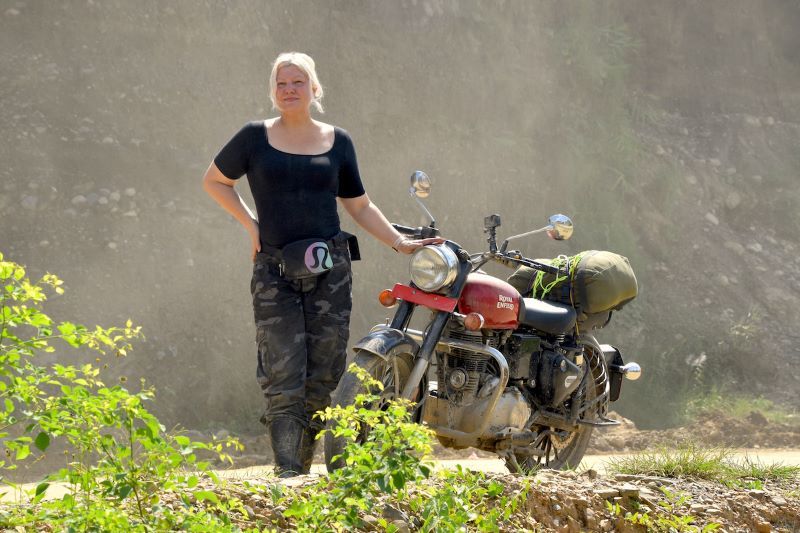
Photo Phoebe Storm
There is no such as thing as ‘safe’ on a motorcycle in Thailand (or indeed anywhere). However, there are a few important things you can do to mitigate some of the many risks.
Don’t forget to get a motorcycle license that you need to ride a bike here legally.
Wear Protective Gear
Ok, we know you’re unlikely to see many riders on the streets of Thailand wearing full-body leathers. But you should never consider taking to the roads without a good-quality (ideally full-face) helmet, proper shoes (not sandals), and hard-wearing clothes like a pair of jeans and a leather jacket.
Ok, granted, those clothes are not going to be much use if you skid on them at speed, but they might save you a bit of skin in a low-speed tumble.
Keep to the Left
According to Thai law, motorcycles should keep to the left-most lane on the road at all times. Unfortunately, this just isn’t practical a lot of the time, as the left lane is also full of turning cars, buses stopping every few feet, vendors pushing carts, pedestrians avoiding dodgy pavements, and so on.
However, it’s a good idea to always aim to keep as far to the left as you can when possible – if you get into an accident in another lane, your insurance may not pay out because of it.
Leave Space
Try to keep at least a car’s length of space between you and the vehicle in front of you. That way if (or as is often the case, when) they do something stupid, you have enough time to react.
Use Your Mirrors
I’m always astounded at the number of bikers I see in Thailand who have outright taken their wing mirrors off. Use them! Vehicles can and do sneak up behind you all the time. If you’re switching lanes when it happens, you’re both going to get into a nasty smash.
Use The Sois
Thailand’s big cities are criss-crossed with hundreds of narrow streets and alleyways called sois. You’d be surprised at how much of the city you can traverse using only these sois with just a little bit of careful planning. Many of these sois are lightly trafficked and absolutely riddled with speed bumps, which makes driving down them a lot safer (although slower) than taking on the main roads.
Don’t Drink & Drive
It’s a no-brainer, but drinking/taking drugs and riding is probably the biggest killer of foreigners in Thailand by far. Don’t do it. Really.
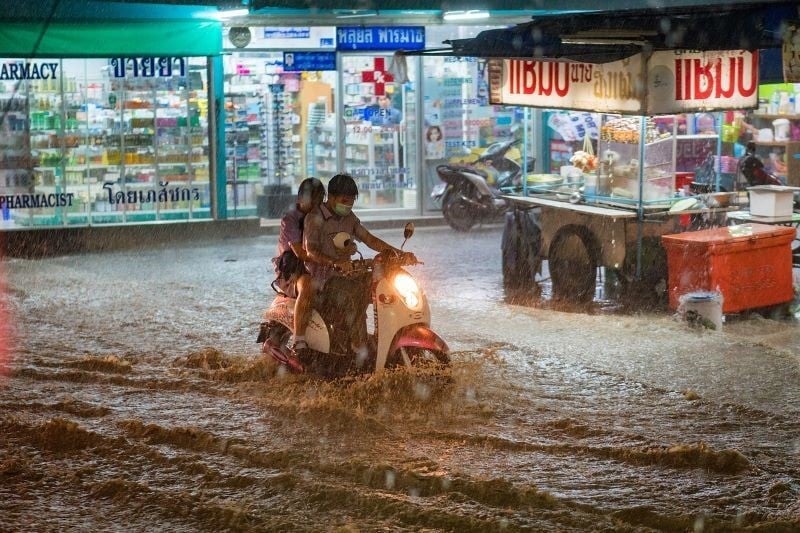
Maintenance
There are no shortage of repair shops around Thailand if you ever need any work done in your bike – it’s no exaggeration to say that there’s practically one on every street. Many are small independent shops – you can usually tell them by the scattered motorcycle parts and air pump outside – but big dealers like Honda also run repair centers.
As a general rule, you should take your bike in for a full maintenance service every 5,000 km. This should include basic care (changing the oil, cleaning filters, checking brake pads and fluid), as well as checks on your tyres and chain tension. You can get this done professionally at your nearest service center, and the process is fairly inexpensive.
Tax
Tax needs to be paid on your bike annually. For the first five years of ownership, the whole process can be completed online at the DLT’s website here. After that, you’ll need to make an annual trip to either your local DLT office or an authorized test center (recognizable by the logo of a yellow cog against a blue background), where your vehicle will be inspected. You’ll need to provide your bike’s green book (see above) and maybe your passport (but it’s unlikely.)
Tax on most bikes shouldn’t break the bank for expats – for example, annual tax on a Honda Click bike is THB 100 (about US$3). Add insurance and the fee and you’re probably looking at around THB 500 annually. Once you’ve paid your money and your bike is cleared, you’ll be given your tax disc. Simply pop it into the capsule on the back of your bike and you’re good to go!
Now, on to You
Let’s not beat around the bush here – riding a motorcycle in Thailand is not for everyone. However, for those who think they can handle it, you’ll find motorcycling here provides you with an unprecedented (if occasionally damp and/or sweaty) level of freedom for when it comes to moving around, and for a very low price compared to driving a car.
There is no shortage of choice, and a robust expat market guaranteeing there’s always a motorcycle out there if you need it. Just ensure you take all the necessary precautions.
If you are not ready to ride a motorcycle here, just buy a car or use public transportation instead.


